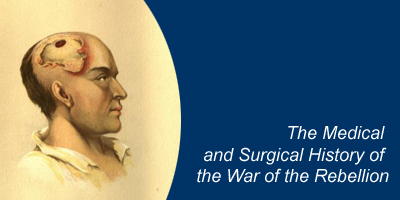

The official beginning of the monumental The Medical and Surgical History of the War of the Rebellion (MSHWR) can be traced to a decree issued by William Hammond on June 9, 1862. The basis of his plan was to accumulate data about the sick and wounded and collect surgical specimens from the battlefield and military hospitals for presentation and detailed study. Hammond's successor, Joseph Barnes, continued his project and was eventually named Editor. Congress agreed to appropriate funds for printing 5,000 copies in 1868 and the first volume was published in 1870. Five additional volumes followed (the last in 1883). The collection, which consisted of almost 3,000 pages and weighed 55 pounds, summarized statistics derived from field hospital reports in a variety of regions and included hundreds of etchings, wood engravings, photographs and color plates of specimens and wounded veterans.


The first volume consists mostly of statistics and monthly reports sent to the Surgeon General by field commanders during the war. The second volume, written by the surgeon Joseph Woodward, is concerned with diseases such as dysentery and "camp fever," which were responsible for many non-battle-related deaths. The descriptions are exhaustive and detailed. Osler himself was reported to have said in a clinic teaching session that "Woodward's work on intestinal fluxes in the Civil War is a perfect mine of information. No article in any language is the equal to his on the subject of dysentery."
The last three volumes document, in case histories and by illustrations, the many forms of battlefield injuries and their sequelae, grouped by the part of the body affected. The work is a remarkable achievement, and in 1878 Hammond reflected,
"There are few things in my professional career in which I take more pride than that the ideas of the Army Medical Museum and of The Medical and Surgical History of the War and the Rebellion were conceived by me."
The entire work has been digitized and is available for viewing at the Internet Archive.